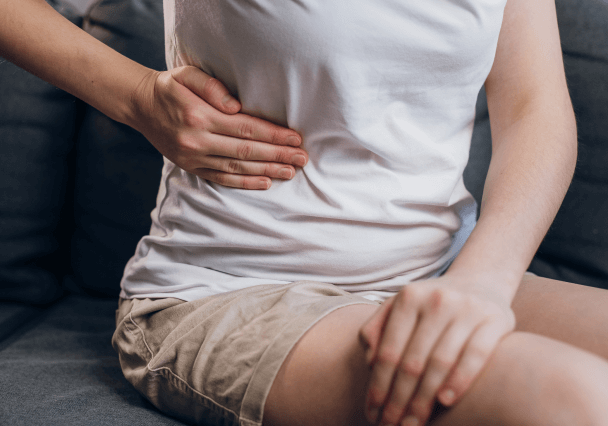
What is Abdominal Pain?
Abdominal pain refers to discomfort or pain that occurs in the region between the chest and the pelvis, commonly known as the stomach area. The pain can vary in intensity and character, ranging from mild discomfort to severe, sharp, or cramping sensations. It can be localized to a specific part of the abdomen or spread across the entire area.



Related Diagnoses

Abdominal Wall Pain

Post-Herniorrhaphy Pain

Abdominal Visceral Pain

Chronic Pancreatitis
Expanded Guide
- Abdominal Wall Pain: Abdominal wall pain is a type of pain that originates from the muscles, fascia, or nerves of the abdominal wall itself, rather than from the internal organs within the abdominal cavity. This pain is typically localized to a specific area and can be triggered or worsened by movement, touch, or pressure on the abdomen. Unlike visceral pain (pain from internal organs), abdominal wall pain does not usually change with digestion or eating. Common causes include muscle strains, trauma, hernias, or nerve entrapment (such as in anterior cutaneous nerve entrapment syndrome). In some cases, previous surgeries can also lead to pain in the abdominal wall due to scar tissue or adhesions.
- Post-Herniorrhaphy Pain: Post-herniorrhaphy pain refers to persistent pain that occurs after a hernia repair surgery (herniorrhaphy). While hernia surgeries are generally successful and aim to relieve discomfort, some patients experience ongoing pain after the procedure, lasting for weeks, months, or even years. This pain is typically localized to the area where the hernia was repaired, often near the incision site. The pain can arise from several factors, including nerve damage or entrapment during surgery, scarring, or mesh-related complications (if surgical mesh was used). In some cases, inflammation or irritation of surrounding tissues may also contribute to the discomfort. The severity of post-herniorrhaphy pain can range from mild to debilitating and may interfere with daily activities.
- Abdominal Visceral Pain: Abdominal visceral pain is pain that originates from the internal organs (viscera) within the abdominal cavity, such as the stomach, intestines, liver, pancreas, or kidneys. This type of pain is usually diffuse, poorly localized, and often described as deep, aching, cramping, or pressure-like. Visceral pain occurs when the organs are stretched, inflamed, or experience reduced blood flow, and it can be caused by a wide range of conditions, including gastrointestinal disorders (e.g., irritable bowel syndrome), infections, inflammation (e.g., pancreatitis), or blockages (e.g., kidney stones or bowel obstructions). Unlike somatic pain, which is sharp and well-localized, visceral pain is often felt in a general area and may radiate to other parts of the body, such as the back or chest. It can also be associated with autonomic symptoms like nausea, vomiting, sweating, or changes in blood pressure. This pain often intensifies with movement or after eating, depending on the affected organ.
- Chronic Pancreatitis: Chronic pancreatitis is a long-term, progressive inflammatory condition of the pancreas that leads to irreversible damage. Over time, this inflammation causes the pancreas to lose its ability to function properly, leading to digestive problems and, in some cases, diabetes. The pancreas plays a crucial role in producing enzymes that help digest food and insulin to regulate blood sugar. In chronic pancreatitis, the inflammation disrupts these functions, resulting in malabsorption of nutrients and the inability to regulate glucose levels effectively. The most common cause of chronic pancreatitis is prolonged heavy alcohol consumption, but it can also be triggered by genetic factors, autoimmune diseases, gallstones, or certain medications. Symptoms include persistent abdominal pain, often radiating to the back, weight loss, diarrhea, and fatty stools (steatorrhea) due to the pancreas’ inability to properly digest fats. As the disease progresses, complications like pancreatic calcification, pseudocysts, or diabetes may develop.
Frequently Asked Questions
Have more questions? Schedule a consultation with Dr. Patel to gain additional insights and discuss treatment options. We are committed to advancing your health through patient education and a safe, minimally invasive approach.
Abdominal pain is diagnosed through a combination of medical history, physical examination, and diagnostic tests. The healthcare provider will ask about the pain's characteristics, such as location, duration, intensity, and triggers, as well as any associated symptoms like nausea, vomiting, or fever. A physical exam involves palpating the abdomen to identify areas of tenderness or abnormal masses. Based on these findings, diagnostic tests may be ordered, including blood tests, urine or stool analysis, imaging studies like ultrasound, CT scan, or MRI, and, in some cases, endoscopy to examine the digestive tract. The specific tests chosen depend on the suspected underlying cause.
Treatment options for abdominal pain depend on the underlying cause. Mild pain from indigestion or gas can often be relieved with over-the-counter antacids, pain relievers, or anti-gas medications. If the pain is due to more serious conditions like infections, inflammation, or organ dysfunction, treatments may include antibiotics, anti-inflammatory drugs, or specific medications to treat conditions like ulcers or gallstones. In some cases, dietary changes, hydration, or rest are recommended. For severe issues, such as appendicitis, hernias, or bowel obstructions, surgical intervention may be required. Long-term management for chronic pain may involve lifestyle modifications, physical therapy, or pain management strategies.
The duration of abdominal pain varies depending on the cause. Acute abdominal pain, often due to issues like indigestion, infections, or minor injuries, may last a few hours to a couple of days and typically resolves with treatment or rest. Chronic abdominal pain, associated with conditions such as irritable bowel syndrome (IBS) or chronic pancreatitis, can persist for weeks, months, or even years, often recurring intermittently. If abdominal pain lasts more than a few days, becomes severe, or is accompanied by other symptoms like fever, vomiting, or weight loss, it may indicate a more serious condition and should be evaluated by a healthcare provider.
Abdominal pain can lead to complications, particularly if caused by serious underlying conditions. If left untreated, issues such as appendicitis, bowel obstructions, or gallstones can lead to severe complications like infections, abscesses, internal bleeding, or even organ damage. Chronic conditions like ulcers or pancreatitis can cause long-term problems, including malnutrition or diabetes. In rare cases, untreated abdominal pain may signal life-threatening conditions like a ruptured organ or aneurysm, requiring emergency medical intervention. Prompt diagnosis and treatment are essential to prevent these complications.
Gramercy Center
Take the first step towards a healthier life by scheduling your initial consultation with Dr. Patel. At our clinic, we specialize in minimally invasive procedures that offer faster recovery, improved function, and decreased pain. Our client-centered approach ensures that you receive the highest quality care tailored to your unique needs. We look forward to offering you an exceptional experience.
